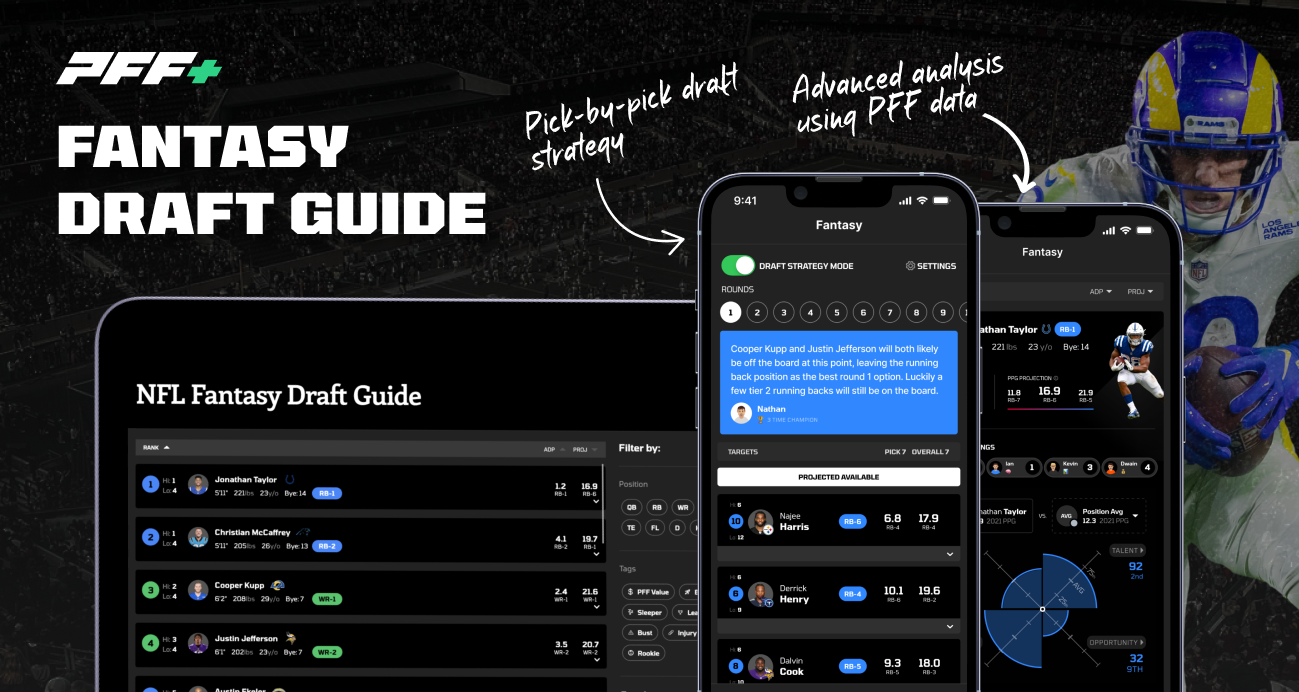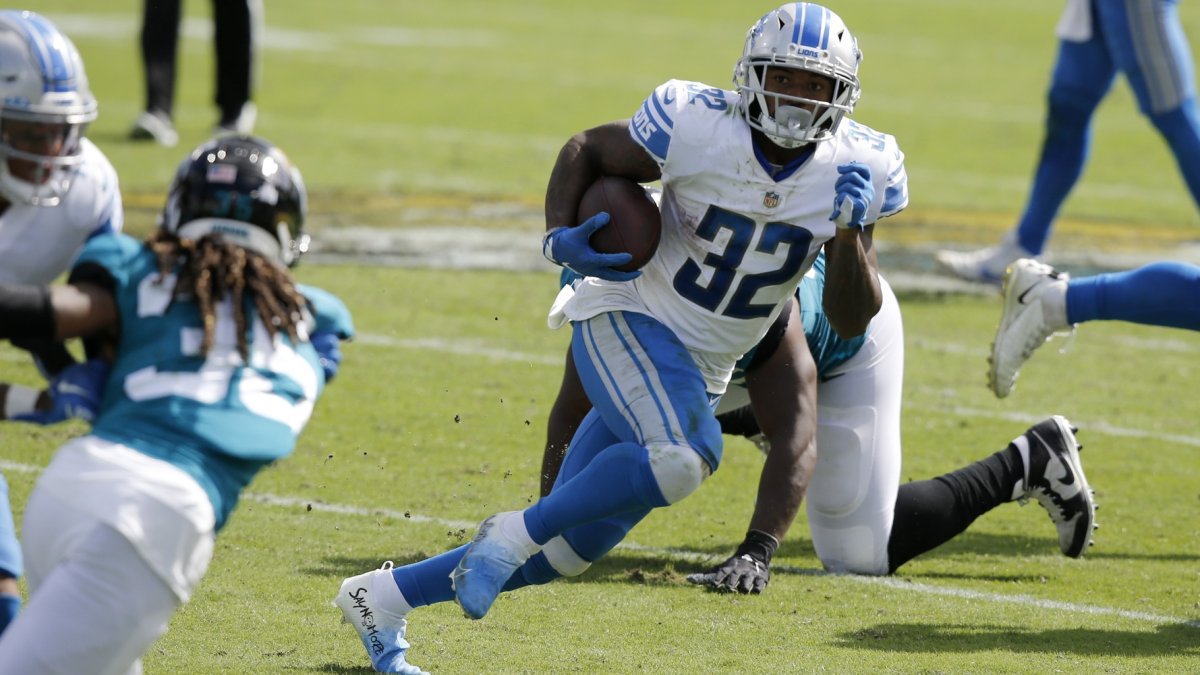• This year offers a unique opportunity for fantasy football drafters to start with three running backs based on the explosive passing-down profiles available in Rounds 2 and 3.
• D’Andre Swift, Saquon Barkley, Javonte Williams and Travis Etienne are all 25 or younger and match the profile we are looking for — all have high-end RB1 upside but some have more challenges to overcome than others.
• Leonard Fournette and Alvin Kamara are veteran options that are worth considering in three-RB builds that go in Round 2.
Anyone who has read my draft strategy articles or listened to the PFF Fantasy Football Podcast knows I don’t subscribe to any single strategy. Say it with me: Every season is different, and every draft is a dynamic, living organism.
Today, we will delve deeper into the reasons why starting your draft with three running backs is a viable option in 2022:
- Running backs carry the highest ceilings, but we must focus on the right profiles and archetypes.
- We have several options that meet our profile criteria in Rounds 2 and 3 this year (which doesn’t occur every season).
- Based on current ADP, we have a lot of options to build out the rest of our roster at quarterback, receiver and tight end.

RB scoring
Since 2011, running backs have dominated the top-three finishes across all skill positions regardless of scoring format.
| PPR POINTS TOP FINISHERS BY POSITION | ||||||||
| Finish: | <=3 | <=5 | <=10 | <=25 | <=50 | <=75 | <=100 | <=150 |
| RB | 67% | 56% | 41% | 36% | 35% | 34% | 34% | 33% |
| WR | 33% | 42% | 54% | 57% | 55% | 54% | 52% | 51% |
| TE | 0% | 2% | 5% | 7% | 9% | 12% | 14% | 16% |
| 0.5 PPR POINTS TOP FINISHERS BY POSITION | ||||||||
| Finish: | <=3 | <=5 | <=10 | <=25 | <=50 | <=75 | <=100 | <=150 |
| RB | 79% | 67% | 53% | 44% | 42% | 37% | 36% | 35% |
| WR | 21% | 31% | 43% | 50% | 50% | 51% | 52% | 50% |
| TE | 0% | 2% | 5% | 6% | 9% | 11% | 12% | 16% |
| STANDARD POINTS TOP FINISHERS BY POSITION | ||||||||
| Finish: | <=3 | <=5 | <=10 | <=25 | <=50 | <=75 | <=100 | <=150 |
| RB | 91% | 84% | 67% | 56% | 47% | 43% | 40% | 37% |
| WR | 9% | 16% | 30% | 40% | 47% | 48% | 50% | 48% |
| TE | 0% | 0% | 3% | 4% | 6% | 9% | 11% | 15% |
Today, we will specifically focus on PPR leagues, but the case for running back ceilings only grows as fantasy managers move to half-PPR and standard formats. In standard leagues, running backs hold the advantage to the top-25 pick mark, and this data doesn’t exclude injury-shortened seasons. That seemed important rather than using points per game because running backs are more likely to suffer an injury.
Considering this equation from a point per game standpoint, since 2011, we have seen 34 players eclipse 22. Of those, 68% were running backs and 32% were receivers.
In PPR formats, receivers move into the lead by the time we get to the top-10 threshold. This is another component of the zero-RB strategy, and how it can create an advantage versus early-RB drafters (we will discuss the WR-WR-WR start in another article).
Drafting three running backs with the first three picks isn’t for the faint of heart, but when fantasy managers hit and win the flex with an elite RB, it can pay big dividends.
In 2017, we saw this perfect storm with Le’Veon Bell, Todd Gurley and Kareem Hunt for drafters who had a top-three selection. Many were down on Gurley due to a poor season before — despite a strong talent profile — and rumors that Lance Dunbar would steal passing-down work. Hunt soared up boards thanks to a Spencer Ware preseason injury and Andy Reid’s historical running back usage but settled in the Round 3 range.
That combination provided fantasy managers with 1,030 total points. For opponents to overcome 67.4 points per game, they would need a ton of firepower, even if you weren’t great at other positions. That threesome pushed me to a No. 2 finish in the Football Guys Players Championship over at the FFPC for $30K.
RB target profiles
We don’t want to target just any three backs when taking this approach. We want to prioritize backs that meet specific criteria. We can set a high bar for this analysis since we focus on ceiling outcomes.
The top three scoring running backs have averaged over 20 points per game since 2011, which is the bar we will use. Backs that didn’t play at least 14 games were excluded.
To find thresholds, I focused on breakpoints that the majority met (65%-plus).
The 20-point-RB profile
Age
- 21 of 27 (78%) were in their age 25 or younger season, averaging 24.6 years old.
Passing game
- 24 of 27 (89%) recorded a 50% or higher route participation, averaging 62%.
- 22 of 27 (82%) eclipsed the 1.30 yards per route (YPRR) threshold, averaging 1.51.
- 18 of 27 (67%) bested the 20% targets per route (TPRR) threshold, averaging 21%.
Rushing game
- 21 of 27 (81%) handled 60% or more of their team’s attempts, averaging 67%.
- 23 of 27 (85%) earned 60% or more of the attempts inside the five-yard line, averaging 81% (this put Austin Ekeler over the top in 2021).
- 22 of 27 (82%) bested the league average (10.5%) in explosive rush rate (10-plus yards), averaging 13%.
Exceptions
- All of the backs that missed the 50% route participation threshold handled 70%-plus of the work inside the five-yard line.
- All of the backs that missed the 60% rush share eclipsed 50% route participation and 50% of attempts inside the five-yard line.
From a talent profile standpoint, we are looking for young backs with explosive playmaking ability and chops in the receiving game. From a utilization perspective, we need a reasonable path to touches on the ground and in the passing game.
2022 RB targets in Rounds 2 and 3
What makes 2022 so interesting at running back are the options available in Rounds 2 and 3 of drafts that meet much of the criteria we have listed above.
The backs below are all viable targets to pair with Christian McCaffrey, Jonathan Taylor, Austin Ekeler or Dalvin Cook from Round 1 of your fantasy draft.
SAQUON BARKLEY | NEW YORK GIANTS | Round 2
Barkley will only be 25 years old this season and has provided us with 24.0 and 18.8 points per game in his two healthy seasons in the NFL. He is a 22% TPRR career player and posted 12% explosive rush rates in healthy campaigns.
The former No. 1 overall draft selection appears destined to dominate an uninspiring depth chart. The only question is whether or not his explosiveness returns – at his age, I am betting on yes in Round 2. Barkley has the RB1 overall in his range.
Exclusive content for premium subscribers

WANT TO KEEP READING?
Dominate Fantasy Football & Betting with AI-Powered Data & Tools Trusted By All 32 Teams
Already have a subscription? Log in



 © 2025 PFF - all rights reserved.
© 2025 PFF - all rights reserved.